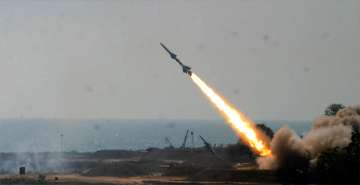Ahead of Trump-Xi meeting, North Korea fires ballistic missile into sea of Japan
Ahead of the summit meet between US President Donald Trump and his Chinese counterpart Xi Jinping scheduled to take place later this week, North Korea today fired a ballistic missile into the Sea of Japan
Ahead of the summit meet between US President Donald Trump and his Chinese counterpart Xi Jinping scheduled to take place later this week, North Korea today fired a ballistic missile into the Sea of Japan, according to US and South Korean officials.
North Korea’s missile test comes days after Pyongyang warned of retaliation if the global community ramps up sanctions against it.
The U.S. Pacific Command said it detected and tracked what it assessed as North Korean missile launched from land near the eastern coastal city of Sinpo. A U.S. statement said initial assessments indicate the type of missile was a KN-15 medium-range ballistic missile. South Korea's Joint Chiefs of Staff said the missile flew about 60 kilometers (37 miles).
The KN-15 missile reportedly refers to what North Korea calls the solid-fuel "Pukguksong-2. The use of solid-fuel missiles is a worrying development because the fuel already being inside the rocket shortens launch preparation times and make it harder for outsiders to detect what's happening before liftoff.
When North Korea test-fired this missile in February, South Korean officials said it flew about 500 kilometers (310 miles) before landing in international waters. It wasn't immediately known if the much shorter distance of Wednesday's flight meant a failed launch.
Ralph Cossa, president of the Pacific Forum CSIS think tank in Honolulu, said he was expecting North Korea would do something to coincide with the Trump-Xi summit, perhaps conduct a nuclear test. The missile launch may be a precursor, with more to come as the summit starts later this week, Cossa said.
"I've joked before that they don't mind being hated but they definitely hate to be ignored," Cossa said.
Recent outside satellite imagery show possible preparations for a new nuclear test at the North's main nuclear test site, such as communication cables used to initiate a test and collect data being already laid. North Korea's state media has also said the world will soon witness what it calls "eventful successes" the country achieves in the space development. Washington, Seoul and others call the North's space program a cover for its long-range missile development program.
Japan's Chief Cabinet Secretary Yoshihide Suga said the country lodged a strong protest over the launch.
U.S. Secretary of State Rex Tillerson acknowledged the launch in a statement but said the U.S. had spoken enough about North Korea and would not comment further.
Analysts says North might time nuclear and long-range rocket tests to the April 15 birthday of North Korea founder Kim Il Sung, the late grandfather of current leader Kim Jong Un.
North Korea is pushing hard to upgrade its weapons systems to cope with what it calls U.S. hostility. Many weapons experts say the North could have a functioning nuclear-tipped missile capable of reaching the continental U.S. within a few years. North Korea carried out two nuclear tests last year.
The North's latest missile launch also came as it is responding annual military drills between the United States and South Korea with weapons tests and harsh rhetoric. North Korea sees the drills as an invasion rehearsal.
Two weeks ago, the South Korean and U.S. militaries said they had detected a failed North Korean ballistic missile launch. Earlier in March, North Korea fired four ballistic missiles that flew about 1,000 kilometers (620 miles), with three of them landing in waters that Japan claims as its exclusive economic zone.
(With AP inputs)
